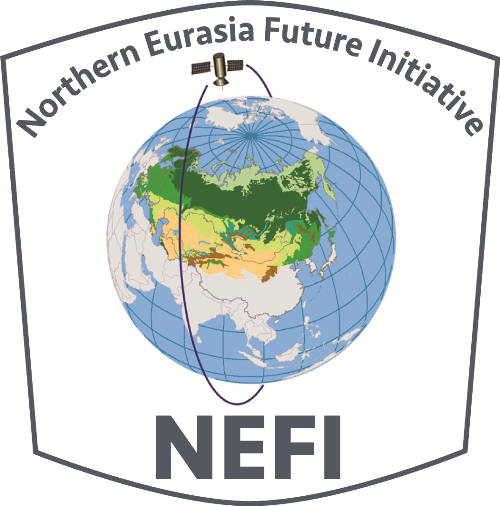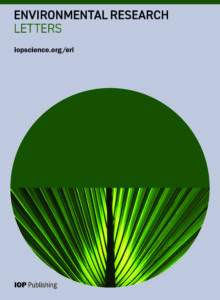ERL特刊精选|Northern Eurasia in the Global Earth and Human Systems

特刊详情
客座编辑
- Pavel Groisman,美国北卡罗来纳州立大学
- Shamil Maksyutov,日本国立环境研究所
- Erwan Monier,美国麻省理工学院
- Dmitry Schepaschenko,国际应用系统分析研究所
主题范围
- How can we quantify and project ecosystems dynamics in Northern Eurasia when these dynamics may be internally unstable?
- What are the major drivers of the ongoing and future changes in the regional water cycles?
- How can the sustainable development of societies of Northern Eurasia be secured in the near future?
To address these questions, nine research NEFI foci have been identified and studies that address these foci in Northern Eurasia will be especially welcome within this focus issue. These include:
- warming of the Arctic;
- changing frequency, pattern, and intensity of extreme and inclement environmental conditions;
- retreat of the cryosphere;
- changes in terrestrial water cycles;
- changes in the biosphere;
- pressures on land-use;
- changes in infrastructure;
- societal actions in response to environmental changes;
- quantification of Northern Eurasia’s role in the Global Earth System.
Due to powerful feedbacks between the Earth and Human Systems in Northern Eurasia, it is proposed that Integrated Assessment Models are developed as the final stage of the global change assessment which will include assessment of sustainable development within Northern Eurasia. This overarching goal of the NEFI modeling endeavor will enable evaluation of economic decisions in response to changing environmental conditions and justification of mitigation and adaptation efforts.
文章精选
Jiquan Chen et al 2018 Environ. Res. Lett. 13 123004
A review of and perspectives on global change modeling for Northern Eurasia
Erwan Monier et al 2017 Environ. Res. Lett. 12 083001
Letters
Jianan Zhang et al 2023 Environ. Res. Lett. 18 035002
M A Aleshina et al 2021 Environ. Res. Lett. 16 105004
The problem of storage of solid waste in permafrost
Valery I Grebenets et al 2021 Environ. Res. Lett. 16 105007
Evgeny G Shvetsov et al 2021 Environ. Res. Lett. 16 115007
The world’s largest heliothermal lake newly formed in the Aral Sea basin
Alexander S Izhitskiy et al 2021 Environ. Res. Lett. 16 115009
Binbin Huang et al 2022 Environ. Res. Lett. 17 014002
Hirohiko Nagano et al 2022 Environ. Res. Lett. 17 025003
Urban expansion inferenced by ecosystem production on the Qinghai-Tibet plateau
Li Tian and Jiquan Chen 2022 Environ. Res. Lett. 17 035001
Atabek Umirbekov et al 2022 Environ. Res. Lett. 17 055002
The roles of global warming and Arctic Oscillation in the winter 2020 extremes in East Asia
So-Hee Kim et al 2022 Environ. Res. Lett. 17 065010
Aleksander G Georgiadi and Pavel Y Groisman 2022 Environ. Res. Lett. 17 085002
Birgit Heim et al 2022 Environ. Res. Lett. 17 085005
P I Konstantinov et al 2022 Environ. Res. Lett. 17 085006
Characterizing land use with night-time imagery: the war in Eastern Ukraine (2012–2016)
Jaemin Eun and Sergii Skakun 2022 Environ. Res. Lett. 17 095006
Kolluru Venkatesh et al 2022 Environ. Res. Lett. 17 095007
The costs of Arctic infrastructure damages due to permafrost degradation
Dmitry A Streletskiy et al 2023 Environ. Res. Lett. 18 015006
Unprecedented acceleration of winter discharge of Upper Yenisei River inferred from tree rings
Irina P Panyushkina et al 2021 Environ. Res. Lett. 16 125014
Vera Kuklina et al 2021 Environ. Res. Lett. 16 115001
Fang Liu et al 2021 Environ. Res. Lett. 16 085001
A Juzbašić et al 2021 Environ. Res. Lett. 16 055008
Divergent responses of ecosystem water use efficiency to drought timing over Northern Eurasia
Mengtian Huang et al 2021 Environ. Res. Lett. 16 045016
Tetsuya Hiyama et al 2021 Environ. Res. Lett. 16 015008
Chuanzhun Sun et al 2020 Environ. Res. Lett.15 125013
T I Moiseenko and N A Gashkina 2020 Environ. Res. Lett. 15 115013
Wanni Yang and Lin Zhen 2020 Environ. Res. Lett.15 115007
Vulnerability of the Caspian Sea shoreline to changes in hydrology and climate
Mahdi Akbari et al 2020 Environ. Res. Lett. 15 115002
Qi Luo et al 2020 Environ. Res. Lett. 15 115001
K M Bergen et al 2020 Environ. Res. Lett.15 105007
Gang Dong et al 2020 Environ. Res. Lett. 15 095009
Simulating interactions between topography, permafrost, and vegetation in Siberian larch forest
Hisashi Sato et al 2020 Environ. Res. Lett.15 095006
Metal bioavailability in northern low-salinity water: Case study of lakes in the Kola region, Russia
T I Moiseenko et al 2020 Environ. Res. Lett. 15 095005
Iuliia Shevtsova et al 2020 Environ. Res. Lett. 15 085006
Jingya Han et al 2020 Environ. Res. Lett. 15 045007
Permafrost degradation in the Western Russian Arctic
Alexander A Vasiliev et al 2020 Environ. Res. Lett. 15 045001
The influence of soil moisture and solar altitude on surface spectral albedo in arid area
Jiaxi Yang et al 2020 Environ. Res. Lett. 15 035010
Kiunnei Kirillina et al 2020 Environ. Res. Lett. 15 035009
Chuanzhun Sun et al 2019 Environ. Res. Lett. 14 125006
The role of river runoff in the Kara Sea surface layer acidification and carbonate system changes
Alexander Polukhin 2019 Environ. Res. Lett. 14 105007
Martin W Miles et al 2019 Environ. Res. Lett. 14 075008
T I Moiseenko et al 2019 Environ. Res. Lett. 14 065010
Dissolved methane in the residual basins of the Aral Sea
E S Izhitskaya et al 2019 Environ. Res. Lett. 14 065005
Elena Parfenova et al 2019 Environ. Res. Lett. 14 065004
A spatio-temporal delineation of trans-boundary ecosystem service flows from Inner Mongolia
Gaodi Xie et al 2019 Environ. Res. Lett. 14 065002
Assessment of post-fire vegetation recovery in Southern Siberia using remote sensing observations
Evgeny G Shvetsov et al 2019 Environ. Res. Lett. 14 055001
Alexander Chernokulsky et al 2019 Environ. Res. Lett. 14 045001
Tracking the spatio-temporal change of cropping intensity in China during 2000–2015
Huimin Yan et al 2019 Environ. Res. Lett.14 035008
Dmitry A Streletskiy et al 2019 Environ. Res. Lett. 14 025003
Chiyuan Miao et al 2019 Environ. Res. Lett.14 025004
Andre Deppermann et al 2018 Environ. Res. Lett.13 025008
Warm Arctic−cold Siberia: comparing the recent and the early 20th-century Arctic warmings
Martin Wegmann et al 2018 Environ. Res. Lett. 13 025009
Projected changes of thermal growing season over Northern Eurasia in a 1.5 °C and 2 °C warming world
Baiquan Zhou et al 2018 Environ. Res. Lett. 13 035004
Mid-depth temperature maximum in an estuarine lake
V M Stepanenko et al 2018 Environ. Res. Lett. 13 035006
Y M Polishchuk et al 2018 Environ. Res. Lett. 13 045002
Surface forcing of non-stand-replacing fires in Siberian larch forests
Dong Chen and Tatiana V Loboda 2018 Environ. Res. Lett. 13 045008
Joanne Hall and Tatiana Loboda 2018 Environ. Res. Lett. 13 055010
T I Moiseenko et al 2018 Environ. Res. Lett.13 065005
Changing snow seasonality in the highlands of Kyrgyzstan
Monika A Tomaszewska and Geoffrey M Henebry 2018 Environ. Res. Lett. 13 065006
Ana Bastos et al 2018 Environ. Res. Lett. 13 065014
Kirsten M de Beurs et al 2018 Environ. Res. Lett. 13 065018
María E Fernández-Giménez et al 2018 Environ. Res. Lett. 13 075010
A high density urban temperature network deployed in several cities of Eurasian Arctic
Pavel Konstantinov et al 2018 Environ. Res. Lett. 13 075007
Yizhao Chen et al 2018 Environ. Res. Lett. 13 075005
L Kupková et al 2018 Environ. Res. Lett. 13 095008
Urbanization and sustainability under transitional economies: a synthesis for Asian Russia
Peilei Fan et al 2018 Environ. Res. Lett. 13 095007
Lin Zhen et al 2018 Environ. Res. Lett. 13 095005
T I Moiseenko et al 2018 Environ. Res. Lett. 13 105007
Dryland belt of Northern Eurasia: contemporary environmental changes and their consequences
Pavel Groisman et al 2018 Environ. Res. Lett.13 115008
Igor Esau et al 2018 Environ. Res. Lett. 13 125009
Mapping growing stock volume and forest live biomass: a case study of the Polissya region of Ukraine
Andrii Bilous et al 2017 Environ. Res. Lett. 12 105001
Spatially distinct effects of preceding precipitation on heat stress over eastern China
Xingcai Liu et al 2017 Environ. Res. Lett. 12 115010
Winter Eurasian cooling linked with the Atlantic Multidecadal Oscillation
Dehai Luo et al 2017 Environ. Res. Lett. 12 125002
Reconciliation of top-down and bottom-up CO2 fluxes in Siberian larch forest
Kumiko Takata et al 2017 Environ. Res. Lett. 12 125012
期刊介绍

- 2022年影响因子:6.7 Citescore: 10.1
- Environmental Research Letters(ERL)以金色开放获取模式出版,作者可选择将原始数据作为补充资料与文章一起发表。所有研究人员可以免费获取这些研究成果。ERL汇聚了关注环境变化及其应对的研究团体和政策制定团体的意见,涵盖了环境科学的所有方面,出版研究快报、综述文章、观点和社论。ERL顺应了环境科学的跨学科发表的趋势,反映了该领域相关的方法、工具和评估战略,得到了来自不同领域的广泛贡献。
